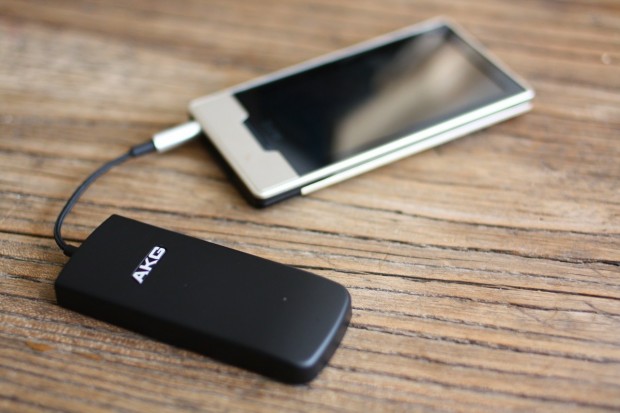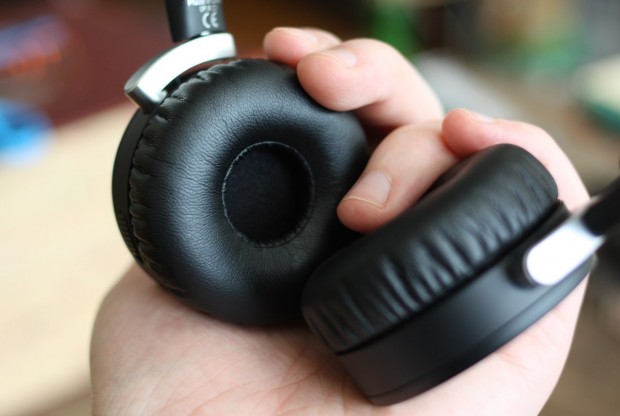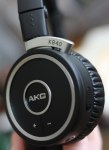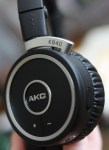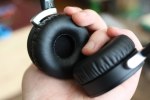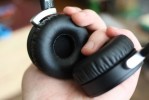
Short version: These headphones are expensive, but they’re also light, compact, and sound great. Pro tip: opt for the Kleer version, as it adds both range and fidelity for a pretty reasonable increase in price.
Features:
- 2.4GHz RF (K840) or Bluetooth (K830) wireless connection
- Kleer audio technology (K 840)
- Compact, fold-flat design and small transmitter
- Battery recharges via wall plug or USB
- MSRP: $300 (K840), $250 (K830)
Pros:
- Light, portable design to headphones and transmitter
- Decent battery life
- Extremely simple operation
Cons:
- On-set volume controls a bit weird
- Short range compared with other RF headphones
- No noise canceling or acoustic isolation
Full review:
Wireless headphones are more or less divided into three classes: tiny Bluetooth-style headsets for mobile phones, larger multimedia headphones for living room use, and the mid-size guys that are meant to travel with you, but not be worn at all times. These new headphones from Harman Audio, the AKG K830 and K840 are in the latter category. They’re lightweight and travel well, but don’t provide the always-there utility of an earpiece or the fidelity or range of the larger, more high-powered models. This isn’t a bad thing, but it’s good to know what they’re shooting for.
I mainly tested the K840 model, which uses RF, since it’s (in my opinion) the more universally applicable model, having a compact dongle that attaches to any 1/8″ audio jack. It also provides better audio quality for those keeping track (what with streaming and compression already taking their toll on fidelity).
 The most important things for wireless headphones in this category are weight, comfort, and ease of use. These AKGs score pretty high all around. They’re quite light, and although they gripped my head securely (sounds like a headcrab), they didn’t seem to press very hard. As I type this I’m testing the battery life, and I’ve been wearing them for just under three hours straight. Due to their on-ear rather than over-ear design, they do press on your a bit in order to get something like a seal, but I’m feeling pretty good and I could probably wear them for another hour or so. They’re only 145g, around a third of a pound, so they don’t add much weight to your head, either.
The most important things for wireless headphones in this category are weight, comfort, and ease of use. These AKGs score pretty high all around. They’re quite light, and although they gripped my head securely (sounds like a headcrab), they didn’t seem to press very hard. As I type this I’m testing the battery life, and I’ve been wearing them for just under three hours straight. Due to their on-ear rather than over-ear design, they do press on your a bit in order to get something like a seal, but I’m feeling pretty good and I could probably wear them for another hour or so. They’re only 145g, around a third of a pound, so they don’t add much weight to your head, either.
Setup is, as it should be for gear like this, extremely easy. Switch the transmitter and headset to the on position, plug in the transmitter to your audio source, and boom, you’re on. I found that going wireless quieted the signal somewhat, but that will differ depending on the system.
Once they’re going, you can adjust the volume by hitting the +/- buttons on the left earcup. I found these to be rather imprecise and overly “clicky.” I’d have much preferred pressing something along the rim of the earcup, or a cool dial like on Nox Audio’s headset. These buttons felt clumsy and clicked loudly in my ear. They worked, but I found myself reaching for the speaker or software volume instead. Set it to “75%” and forget about it is my advice.
Range depends first on which model you have (Bluetooth obviously is much shorter, but requires no extra transmitter), but I wouldn’t say it’s remarkable either way. These aren’t for going outside and shoveling the walk with, they’re for cutting down on cord clutter, going across the room to sit down or grab a book, or popping over to the kitchen for a drink. If you interpose more than two walls between you and the transmitter, forget about it. It easily reached my kitchen through two walls and about 15 feet, but going into the closet (two thicker walls, ~25 feet) in my bedroom led to gaps in the audio. In the room with the transmitter there was never any delay or skippage.
Sound is good. Bass is somewhat de-emphasized (you can only expect so much with an over-ear model), but it’s present and accounted for. Clarity is good, and classical music sounded great, with small details like the breathing of the pianist coming in loud and clear. Comets on Fire was plenty loud, and Outkast was punchy. No complaints at all about the sound.
Battery life is 4+ hours with a full charge. I turned these on at 2:50PM and they’re still going now at a quarter to 7. Charge time I neglected to record (sorry), but it wasn’t super long. Your mileage may vary, of course.
Build quality is solid, though being light and compact they do naturally feel a little fragile. They took some serious bending and I didn’t hear any tension squeaks or cracks. The earcups are very soft in both texture and cushioning, and I found them comfortable to wear. The expansion setting on the headband is maintained when you fold the headphones up, which is nice.
These AKG cans look remarkably similar to TDK’s WR700 headphones, and both offer Kleer and a compact, portable design. I haven’t tested them out, but presumably they provide similar performance, though Harman Audio would object on the grounds that the actual headphone unit is higher quality. Fair enough. Still, it’s a hundred dollar difference for a similar product and worth mentioning.
Conclusion
First off I think it is worth the extra $50 for the Kleer version, since that comes with less hassle, better sound, and longer range. If you can’t stand the idea of having a little doodad attached to your audio source, go with Bluetooth, sure, but if it were my money I’d stick with the Kleers. Now that that’s out of the way, it’s a question of whether it’s worth the three hundred. If you have no need for the extra-compact size, and most of your use will be at a desk or couch, go look into Sony, JVC, or Sennheiser; they have nice over-ear options for $50-$100 that will probably serve you better. But if you’re planning on traveling or plan on taking these to and from work, say, or want to use your headphones at a cafe, these are up your alley. If your credit can handle it, however, consider picking up a cheaper pair like the TDKs mentioned above and see if you can tell the difference. If you can’t, what are you paying for?
Product page: AKG K840 (Kleer) and K830 (Bluetooth) headphones
